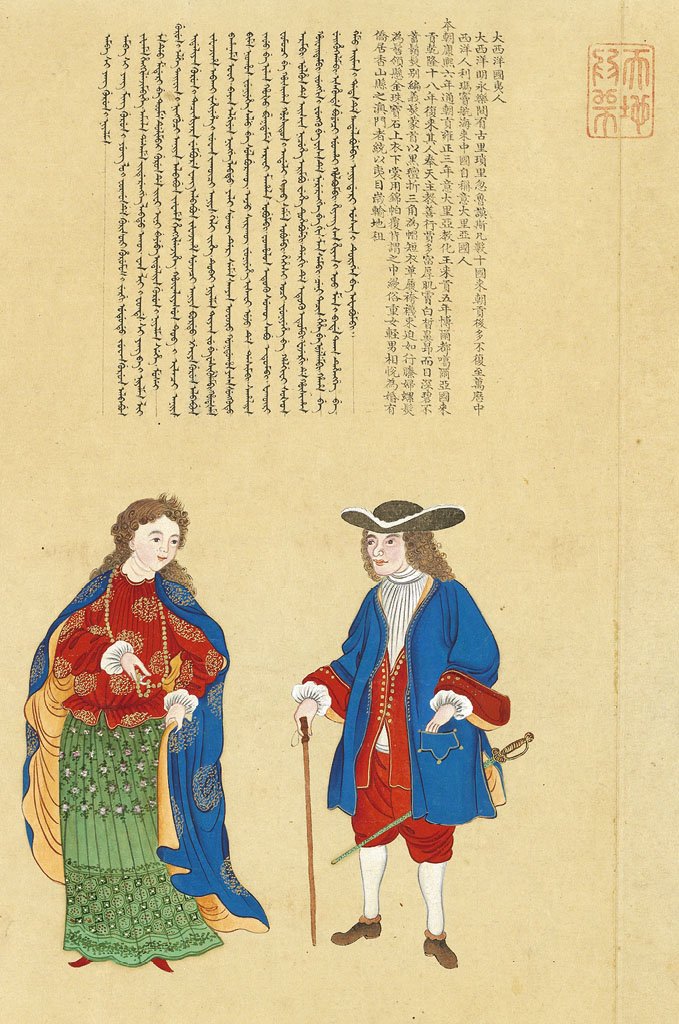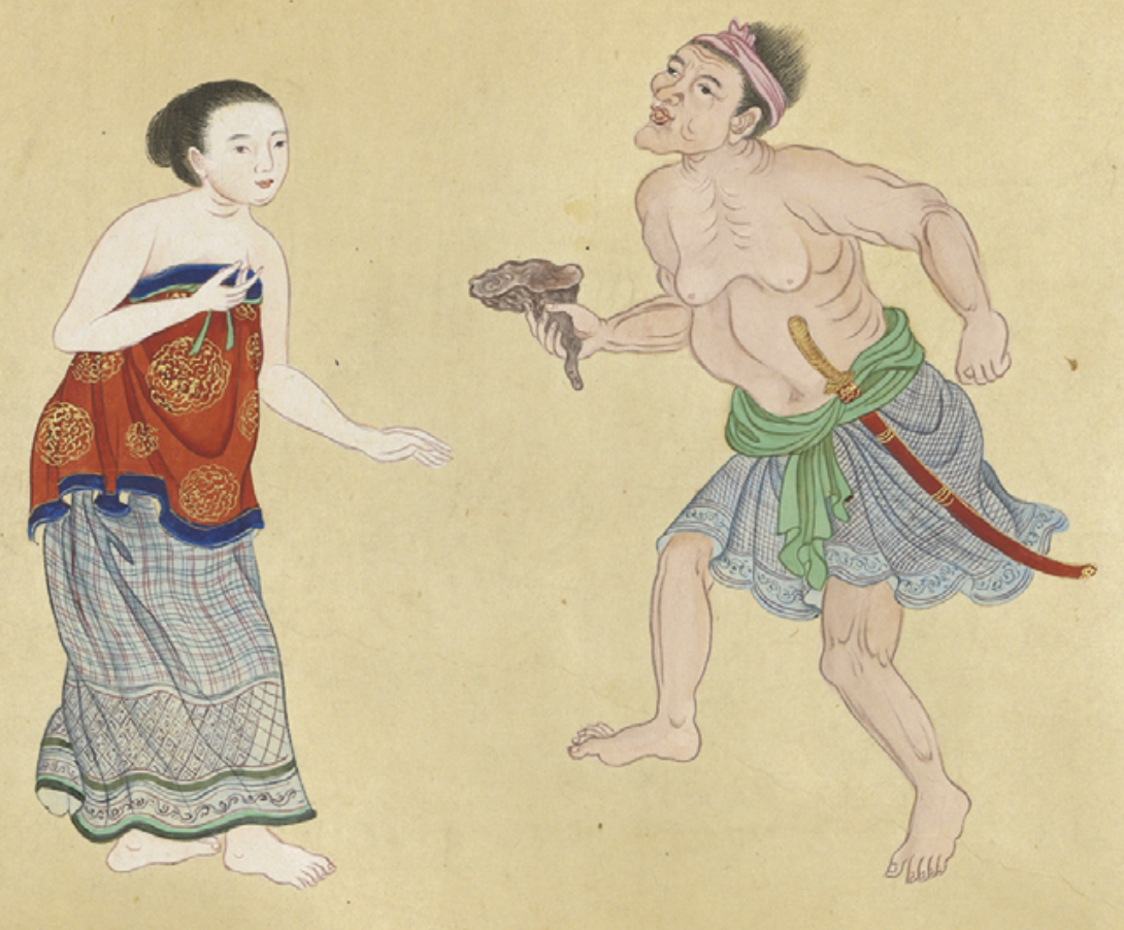The Huang Qing Zhigong Tu: a Qing view of the Occident
By Thomas Gibbs
“[Englishmen] mostly wear woolens and are fond of drinking”
The Huang Qing zhigong tu (皇清職貢圖) is a Qing dynasty ethnographic study, what Laura Hostetler calls a ‘cultural cartography’ of the known world. The scrolls were commissioned in 1751 by the Qianlong Emperor to allow foreigners to be identified and categorised by the state; an English translation of the title is ‘Qing Imperial Illustrations of Tributary Peoples’. It exemplifies both the tributary-trade system of Qing dynasty China, and Qianlong’s claim to be Universal Emperor – every other nation is presented as a subordinate tributary to his. The study is apparently the work of many years, and multiple artists and writers; the descriptions of the ‘Peoples’ vary massively, with some placing far more emphasis on economic matters and other cultures. Today it survives in various editions, most notably the Xie Sui edition (c. 1790s) held in the National Palace Museum, Taipei, which is filled with large, sumptuous colour illustrations. Each page (or block, it is in fact spread across a series of horizontal scrolls) consists of a male and female figure representing a people, including their clothing, surrounded by a description of the people in both Chinese and Manchu. Of the 301 listed people’s most are Southeast Asian, with many having two entries: one for officials and one for common folk. A fascinating few pages, however, depict Europeans, the ‘people from the Atlantic Countries’.
Europeans are reportedly ‘skilled at commerce and many are wealthy and influential.’ This reflects the primary observation ground for the writers: European traders. The Europeans are racially stereotyped: ‘Their flesh is white, their noses are prominent, and their eyes deeply set and greenish blue. They do not grow their hair or beards, but fashion wigs of false hair to cover their heads with instead.’ The format of every entry is uniform in this regard, beginning with key points of Chinese contact with the people, and political matters (for example, ‘In the Atlantic countries they have two rulers, one for religious and one for secular matters.’ – the King and the Pope), then detailing the stereotypical nature of the people, before moving onto typical fashion (in this case ‘three-cornered hats of black felt, short upper garments, and leather shoes’), and finally social dynamics and what often feels like trivia. This latter section is particularly revealing of Chinese observations, for example of the Atlantic People the scroll says ‘According to their custom women are valued more highly than men. Marriages are based on mutual affection.’ From which we can infer the opposite about contemporary Qing court culture. There is considerable potential for reading against the text here; particularly in the realm of gender, as both male and female figures are shown and described. One author is impressed, for example, by Polish women who are ‘talented and capable. They manage household affairs unassisted, keeping the interior and exterior in order.’
Xie Sui, ‘People from Atlantic Countries’ Detail from: Huang Qing Zhigong Tu (皇清職貢), late Qing Dynasty (c. 1790), scroll. National Palace Museum, Taipei.
The illustrations are in a courtly Chinese style, with defined lines and an emphasis on flowing fabrics – often presented in a slightly abstract way like the folds in the Atlantic woman’s cape. Colour is sumptuous in this version with markedly contrasting colours and limited use of varying shade beyond simple chiaroscuro. The emphasis is on full block colour. This reflects their role as a treasurer of the Emperor, something beautiful and impressive. Although it is not shown in these images the scroll also has chops and inscriptions from its various owners through the years. Skin tones are always very white and pale, in keeping with Chinese portrait painting, although there is variation between the “races” portrayed.
Xie Sui, ‘Black Demon Slaves’ Detail from: Huang Qing Zhigong Tu (皇清職貢), late Qing Dynasty (c. 1790), scroll. National Palace Museum, Taipei.
A notable exception to the pale skin tones comes in the rather uncomfortable section on the ‘black demon slaves kept by foreigners’, presented in European dress to highlight their servitude to the Europeans and to contrast the greyish pigment used for their skin. Interestingly, here the illustration contradicts the text that describes slaves as ‘black as lacquer.’ Both text and illustration showcase African jewellery and ‘strips of black leather for shoes, which makes it convenient to walk quickly.’ The text also comments non-judgementally on giving slaves European food in a practice known as ‘huanchang’ which has two meanings: ‘changing the bowels/removing the feelings’ so that they become a non-rebellious slave. This is an obscure reference to, and misunderstanding of, the ‘bloody flux’ dysentery rampant on slave ships. Dehumanising language referring to eating leftovers out of ‘one dish like a horse’s trough’ and the verb xu (畜) which means both to keep and to rear (like a pig) is not reflected in the illustration which presents the figures in a far less racially caricatured way than the scrolls portray the Cambodians, for example.
Xie Sui, ‘People of the Country of Jianpuzhai (Cambodia).’ Detail from: Huang Qing Zhigong Tu (皇清職貢), late Qing Dynasty (c. 1790), scroll. National Palace Museum, Taipei.
There are references in the text to colonial relations, but these are generally not reflected in the illustrations. For example, Portuguese men are ‘strong, fierce, and versed in weaponry.’ Yet the Portuguese male figure is a portly and meek-looking gentleman, taking his hat off to be polite – a Western practice the text is noticeably intrigued by, along with carrying snuff in golden threads. One exception to this is the Philippines, which are recorded as being conquered by the Portuguese but remaining worthy of a separate entry. The male figure for the Philippines is clearly a European coloniser.
Xie Sui, ‘People of the Country of Luzon (the Philippines).’ Detail from: Huang Qing Zhigong Tu (皇清職貢), late Qing Dynasty (c. 1790), scroll. National Palace Museum, Taipei.
Frequent comparisons are made to the Dutch, with whom the Qing had an ongoing trade relationship, and both England and Sweden are incorrectly listed as Dutch tributaries. The former likely due to a misunderstanding of the complex constitutional arrangements around the reign of William of Orange. As a reflection of its colonial status, the Dutch are listed in this edition with other Asian nations like Japan (which the text describes in highly unflattering terms that reflect their ongoing rivalry).
Xie Sui, ‘People of the Country of Poland.’ Detail from: Huang Qing Zhigong Tu (皇清職貢), late Qing Dynasty (c. 1790), scroll. National Palace Museum, Taipei.
In the illustrations all Western Europeans appear to be modelled on the Dutch with variations in costume and props where the text demands it. Thus, the Polish man is holding a bear, because bear taming was apparently a popular pastime in Poland. The Englishmen, meanwhile, who ‘mostly wear woollens and are fond of drinking’, are represented gazing at a bottle of alcohol. Their entry is shorter than most, likely due to a lack of contact. More information, and more detailed caricature, is given for more often contacted peoples. This extends to European monks and nuns, who are given their own entry, likely because of their ‘temples’ in Macau and their presence at the Qing court. This is reflected in the comment that ‘They understand Chinese and are able to make scientific instruments.’ The Jesuits saw missionary artists embedding in the Qing Court and taking commissions as a foothold to eventually convert China; missionaries record how Qianlong exploited this with a workshop of missionaries making him European trinkets, scientific devices, and other artifacts for his collection. It is this Jesuit mission that perhaps leads the scroll to incorrectly assert that the Portuguese ‘At first… followed Buddhism and later Christianity’ because the Jesuits initially adopted the robes of Buddhist monks, before switching to Confucian scholar’s robes. In this scroll, however, Christians are presented in Western garb – albeit with a wispy Chinese-style beard to suggest learning.
Xie Sui, ‘People of the Country of England.’ Detail from: Huang Qing Zhigong Tu (皇清職貢), late Qing Dynasty (c. 1790), scroll. National Palace Museum, Taipei.
The text reads:
‘England is a tributary of Holland. The clothing and ornaments of their people are similar. The country is rather wealthy. Men mostly wear woolens and are fond of drinking. Women bind their waists before marriage, desiring them to be thin. They spread their hair out, letting it fall to their shoulders. They wear short upper garments and long skirts. When going out they add an over- coat. They use a golden thread for their stash of snuff, which they keep on their person.’
Xie Sui ‘Monks and Nuns of the Atlantic Countries. Detail from: Huang Qing Zhigong Tu (皇清職貢), late Qing Dynasty (c. 1790), scroll. National Palace Museum, Taipei.
This is an incredibly long and dense text that deserves much more thorough investigation. On first discovering it I was reminded of a similar 1920s children’s book a friend of mine owned, covering the Orientalised stereotypes of every nation of the British Empire – what they wore, what they ate, and so on. I wondered if it was possible this was the inverse, a stereotyping of the West by the East. Occidentalism is a controversial concept in cultural theory, a reversal of Edward Said’s theory that the West defines itself against an imagined and stereotyped Orient claiming that the East also stereotypes the West. It has been critiqued by post-colonial scholars for failing to understand the power dynamics inherent in Said’s theory; Orientalism is a form of domination through norm-making that the subordinate cannot easily reverse. However, the broadest definition of Occidentalism as ‘any reductive representation of the West that takes the East as its starting point’ is an interesting lens through which to view artifacts such as this one. However, I will let you decide whether it applies, because the whole Xie Sui edition is available in translation at: https://brill.com/display/title/60180
Notes:
Bottici, Chiara, and Challand, Benoît. The Myth of the Clash of Civilizations. 1st Edition (London: Routledge, 2010)
Helene, Andrew P. "Review: Occidentalism" in The SAIS Review of International Affairs, Vol.24, No.2 (2004): pp.181-184.
Hosteler, Laura, and Xuemei Wu (Eds and trans.). Qing Imperial Illustrations of Tributary Peoples (Huang Qing zhigong tu): A Cultural Cartography of Empire. (Leiden, Boston: Brill, 2022)
Leijh, Hans. "The Qing and their tributaries Qing perceptions of European and Steppe-peoples." MA Thesis, Department of History, University of Leiden, 2019
Margalit, Avishai and Buruma, Ian. Occidentalism: The West in the Eyes of Its Enemies. (New York: Penguin Books, 2005)
Musillo, Marco. "Reconciling Two Careers: The Jesuit Memoir of Giuseppe Castiglione Lay Brother and Qing Imperial Painter" in Eighteenth-Century Studies Vol.42, No.1 (2008): pp.45-59.
Raja, Masood. "Why Occidentalism is a Silly Concept." YouTube. August 11 2020. [Accessed November 30, 2022] https://www.youtube.com/watch?v=DWbTm6-bc30.
Zhou, Anna. How did 18th-century Chinese imagine the Poles?, n.d, [Accessed November 30, 2022] https://polishhistory.pl/how-did-18th-century-chinese-imagine-the-poles/







